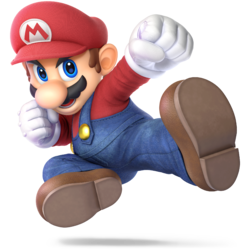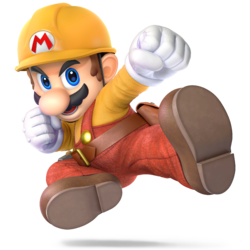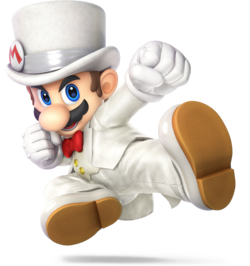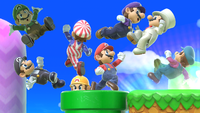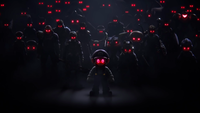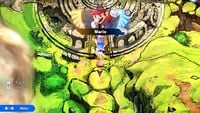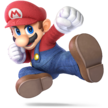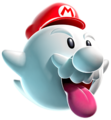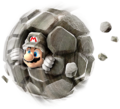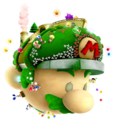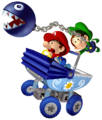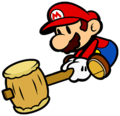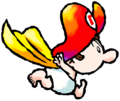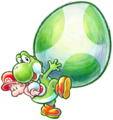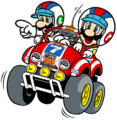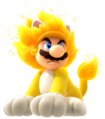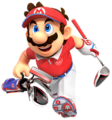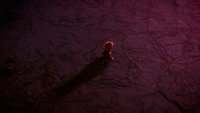| Welcome to SmashWiki! Log in or create an account and join the community, and don't forget to read this first! |
| Notices |
|---|
| The Skill parameter has been removed from Smasher infoboxes, and in its place are the new "Best historical ranking" and "Best tournament result" parameters. SmashWiki needs help adding these new parameters to Smasher infoboxes, refer to the guidelines here for what should be included in these new parameters. |
| When adding results to Smasher pages, include each tournament's entrant number in addition to the player's placement, and use the {{Trn}} template with the matching game specified. Please also fix old results on Smasher pages that do not abide to this standard. Refer to our Smasher article guidelines to see how results tables should be formatted. |
| Check out our project page for ongoing projects that SmashWiki needs help with. |
Mario (SSBU)
| Mario in Super Smash Bros. Ultimate | |
|---|---|

| |
| Universe | Mario |
| Other playable appearances | in SSB in Melee in Brawl in SSB4 |
| Availability | Starter |
| Final Smash | Mario Finale |
| Tier | A (22) |
Mario (マリオ, Mario) is a playable character in Super Smash Bros. Ultimate. He was suggested to appear in the then unnamed Ultimate in its first teaser trailer at the end of the March 8th, 2018 Nintendo Direct, and officially announced in Ultimate's E3 2018 trailer on June 12th, 2018 alongside the rest of the returning roster. Mario is classified as Fighter #01, the first fighter number of the Super Smash Bros. veterans and the overall roster. As in Super Smash Bros. 4, Charles Martinet's portrayal of Mario from Brawl was repurposed for Ultimate in all regions.
Mario is currently ranked 22nd out of 82 characters on the tier list, being in the A tier. This is a slight drop from his 9th out of 54 ranking in Smash 4 where he stood at the lower end of top tier, despite not facing many changes during the transition. Much like his previous incarnation, Mario's greatest asset is his fast frame data; most of his moves have little startup lag and have relatively low end lag. This results in Mario being fairly difficult to punish relative to most of the cast. His combo game is quite flexible, as Mario can rack up damage quickly and reliably with a myriad of options to do so. In particular, his up aerial is one of the best juggling tools in the game, as the move can very easily chain into itself and can lead to near inescapable kill setups either on the top blast line or near the ledge. In addition, he also has a versatile moveset: a disruptive projectile in his Fireball, a reflection-based and reverse-based move in his Cape that can counteract camping, and a decent, if niche edgeguarding option with F.L.U.D.D.
However, Mario also has some notable weaknesses. His moves have short range, with his hitboxes being relatively small and stubby when compared to the rest of the cast. This causes him to have difficulty against characters with long or disjointed range. Mario also suffers from a lack of consistent KO setups, due to having predictable, low range, and unsafe kill options at high percents, alongside his short frame and relative floatiness for a middleweight. He also struggles at KOing opponents in general, as he lacks any reliable finishers outside of his smash attacks: while his back throw is slow and vulnerable to DI and other moves like back aerial, down aerial and Super Jump Punch tend to be dependent on edgeguarding or being near the top of the blast line to KO. Mario’s recovery, while good, is still predictable due to Super Jump Punch only travelling a mere average distance. Lastly, Mario's average attributes do not allow him to quickly gain an advantage either, as the strengths of other characters can contest his, with the most notable being his overall range.
Overall, Mario's strengths outweigh his weaknesses, and he has seen strong results in competitive play thanks to the efforts of players such as Dark Wizzy, Kurama, and Snow.
Attributes
Mario is a short middleweight with relatively balanced attributes, possessing slightly above average walking speed, air acceleration, dashing speed and weight, whereas his falling speed and gravity are below average relative to the cast. He also has a very fast air speed (tied with Sonic, Donkey Kong, Little Mac and Inkling for the 12th fastest in the game) and excellent jumps, in exchange for poor attack range and moderately low traction. These balanced stats don't give Mario the edge when it comes to overall movement, but they nevertheless make him adept at most situations where a key attribute is needed to gain the advantage, which when combined with his very quick frame data, grants him a great neutral game. As a result, despite his attributes implying a jack-of-all-trades type of character, Mario is somewhat more of a rushdown character in practice.
Thanks to his incredibly quick attack speed, Mario shines in close-quarters combat. His fast attack speed allows him to consistently apply pressure to the opponent, and he is capable of quickly racking up damage once he gets the momentum, which is easy to do so on characters that cannot match his attack speed without getting heavily punished for it. Excluding his forward smash, forward aerial, and special moves, all of Mario's moves have fast startup and low ending and landing lag (the latter in the case of his aerial attacks, except for his aforementioned forward aerial). All of his grounded moves are prime examples of his quick frame data: his neutral attack is his fastest move and an overall effective way to rack up damage, along with handy combo capabilities, while his up and down tilts are effective combo starters that can help rack up plenty of damage, and the former chains into itself at low percentages. All of his smash attacks are decent KO options, as they can reliably KO at high percentages and have low ending lag; his forward smash has a powerful sweetspot located on the fiery explosion that he emits from his palm and possesses the highest power of all of his smash attacks, down smash is a semi-spike, making it useful for forcing opponents offstage, and up smash is very hard to punish due to its speed, power and slight disjoint due to the intangibility it grants on his head.
Mario's aerial attacks are also very useful in many cases. Neutral aerial is a sex kick that can be useful in edgeguarding or for breaking combos. Back aerial has the longest reach and the highest knockback of Mario's aerial moves, allowing it to space effectively and reliably KO offstage. Up aerial's extremely quick startup, vertical launch angle and lack of sourspots let it combo into itself or other moves, on top of letting it easily break or set up combos. Mario Tornado, which is Mario's down aerial, is a great anti-juggling move that also has respectable power, especially if used near the upper blast line. Finally, his forward aerial is a meteor smash with high base knockback for one, making it great for gimping all but the farthest-reaching of recoveries and being an extremely effective KO option offstage.
His special moveset is highly varied and has plenty of uses. Fireball is a projectile with a decently long range. It can be useful in the neutral game or in edgeguarding, thanks to its disruptive knockback and downward trajectory, and is very useful for disrupting direct approaches. Super Jump Punch travels in a controllable diagonal direction and grants moderate distance, making it good at recovery. It also has intangibility upon startup, allowing it to be used out of shield very effectively. Due to its extremely quick startup, it is also a useful combo finisher, especially near the blast line. Cape reverses opponents, with the induced disorientation often being enough to allow a free hit or efficiently gimp a recovery, which aids in edgeguarding opponents. It is also a powerful reflector, making it highly useful in matchups against projectile-heavy characters, such as Simon or Samus. F.L.U.D.D. is a mechanism that shoots water, pushing opponents away, which compliments his Cape. Though situational, it can occasionally be used to give Mario some breathing space. As a result of his Cape, F.L.U.D.D. and his fast aerials, Mario also boasts a versatile edgeguarding game.
Another valuable strength of Mario is his grab game. Though his grab reach is somewhat average, his dash and pivot grabs extend far past his hurtboxes, granting them unusually disjointed range for a character of his archetype. In addition, his grabs are tied for the fastest in the game, and his pummel is fairly quick. His forward throw sends the opponent at a disadvantageous position, where Mario can capitalize on their mistakes. His up throw is a useful combo starter at lower percentages, comboing into his up, down, and back aerials. His back throw is by far his strongest throw and one of the strongest of its type in the game as well, as it can reliably KO at around 160% near the ledge on any character, and even earlier with rage, being capable of killing as early as 107% with it. Finally, his down throw is a great combo starter that can lead a vast amount of combo opportunities, most notably his up, back, and forward aerials.
Finally, and due to the favorable angles his moves send at, his tremendously quick frame data and his extensive amount of combo starters, Mario's combo ability is fantastic, and it is also worth noting that several of Mario's moves can lock, including his neutral attack. This makes it almost always imperative for Mario's opponent to tech all attacks at low to mid percentages when needed; otherwise, Mario can capitalize on the opportunity, and tack on unavoidable massive damage in the process.
Despite Mario's numerous strengths, he is not flawless. His attributes, while well-rounded, are not exactly exceptional, as many characters outclass him in various ways. Notable examples of this include Pikachu having a more versatile edgeguarding game, Luigi and Kazuya having better combo potential, Steve having a superior camping game, Sonic having substantially faster mobility, Bowser having significantly stronger attacks, Snake and Sora having a much more effective recovery, and Shulk and Min Min having drastically larger reach. In particular, the last one is his main weakness: his attacks generally possess relatively poor range.
His lack of reach (which was further worsened by the changes to his up-tilt and dash grab) prevents him from fighting at a safe distance, and consistently forces Mario to approach characters on his own. This leads to him having great difficulty against characters with large or disjointed range, particularly weapon users like Lucina and Cloud. While back air is Mario's most effective spacing tool, it too suffers from a mediocre range that limits its utility against disjointed attacks, and fireball, while an overall solid projectile, is slow and lacks transcendent priority, which means it can easily be beaten by any attack with a large hitbox, making it mostly an unreliable tool for camping. While Mario's pressuring capabilities are formidable, his susceptibility to getting spaced out is among the worst in the game due to his moves possessing very stubby and small-sized hitboxes, this results in Mario having a lot of difficulty in approaching and getting his combo game started if his opponents space him properly, as even a character with a slightly disproportionate disjoint can severely limit his ability to get in. In such cases, he will often be forced to rely on reads and make good for what he has when he gets an opening.
Another notable weakness is that Mario can also have some difficulty scoring KOs, as he has few strong and reliable finishers and can have difficulty landing them, especially at high percents, which are further compounded by his short range, which limits his options. Outside of his forward and up smashes, none of his other KO moves are very reliable and consistently effective for doing what they're supposed to: his down smash can only KO reliably with its back hit and is unsafe on shield, Super Jump Punch can only KO at very high percentages or close to the blast zones, his back aerial has short range and is unsafe against disjoints, his down aerial has even shorter range and can sometimes have trouble connecting, his back throw is very slow and very susceptible to DI, and his forward aerial is slow and must be sweetspotted (mid hit) in order to meteor smash, while the early hit and late hit (first and last active frame, respectively) have too much ending lag to be used as a combo extender while still being unreliable for killing due to their rather low knockback. Because of this, Mario tends to rely too much on his forward and up smashes or reads to score a KO, and his inconsistent KO potential is further worsened by the changes to rage, which hinders him more than other characters, as it doesn't increase knockback as much as in SSB4. Since it also no longer affects set knockback, he can't use his Super Jump Punch’s connecting hits as a KO confirm at low percents anymore if he has high rage, similarly to Samus's Screw Attack and Peach Parasol. Because of this, he must keep his forward and up smashes fresh and be careful to not get predictable especially with the existence of stale-move negation. While his forward and up smashes are considered among the best of their type, they have their flaws too: the former has noticeable endlag and a sourspot located on Mario's arm, which, while very difficult to hit with, outprioritizes the sweetspot and has rather mediocre power, while the latter has poor range in front of him, to the point where it will sometimes miss completely against short or crouching characters.
Lastly, despite being known for his jumping ability (hence his original nickname, Jumpman), Mario's recovery is easy to gimp and is quite predictable. Despite his fast air speed and high double jump, Super Jump Punch, while fast and relatively safe, travels a merely average amount of distance altogether. This means that if Mario is knocked off stage without his double jump, he is extremely vulnerable to edgeguarding, and one hit could be all it takes to kill him. This also leaves Mario very vulnerable to semi-spikes, as they will likely launch him too far to recover at high percentages. Aside from Super Jump Punch, Mario has no other recovery options aside from utilizing Cape's momentum stalling as a mix-up. Nevertheless, Super Jump Punch still offers a serviceable amount of recovery ability and can get the job done, should it be used properly.
Overall, Mario has many clear strengths and very few exploitable glaring weaknesses, resulting in said strengths outweighing said weaknesses. All in all, his above average mobility and largely reliable combo ability allows him to get the edge easily against most characters, as it is hard to escape from his wrath once he gets the advantage, while it is also easy for him to escape from his opponents’ wrath and regain the advantage. However, because of his low range, Mario must almost always fight in close quarters, and he often relies on reads to secure KOs. Mario has to be very careful off-stage as well in spite of his respectable edgeguarding game, as one exploit of his defenses can cause him to be unable to recover.
Changes from Super Smash Bros. 4
Mario has undergone a mixture of buffs and nerfs in his transition to Ultimate, but despite being directly nerfed overall, the indirect changes to the game's engine drastically benefit his playstyle, and he has also received buffs to some of his underwhelming moves from his SSB4 incarnation. As a result, it is difficult to determine if he was buffed or nerfed overall.
Mario has received a few direct noteworthy buffs. Fireball has reduced endlag, a slightly larger hitbox, and inflicts more hitlag on opponents, greatly improving its safety and follow-up potential. F.L.U.D.D. has reduced ending lag and a stronger pushback effect as a result of its increased set knockback, allowing Mario to disrupt and edgeguard opponents with it more effectively. As a result of his buffed specials, Mario's approach and already oppressive edgeguarding ability have been improved. A few of his standard attacks have received buffs as well; forward tilt is much more effective as a spacing option due to its higher base knockback, lower ending lag, and the increased shieldstun for tilt attacks. Additionally, his down aerial connects more reliably than before and deals increased damage and knockback, improving its damage-racking capabilities and KO potential. Forward smash also deals consistent damage across all angles, and when angled up or down, has increased knockback scaling, slightly improving its already impressive KO potential even further.
Mario also benefits heavily from the changes to Ultimate's mechanics. His already strong set of aerials has been improved even further as a result of the universal reduction to landing lag; this not only makes them safer on shield despite the reduced shieldstun on aerial attacks, but it allows for more reliable combos and even devastating KO setups, such as up aerial into forward aerial. This is complemented by the universal 3-frame jumpsquat, with his up throw in particular becoming a much more effective combo starter as well. The universal increase to mobility further improves Mario's approach and allows him to string attacks together more effectively and close in on opponents more effectively. Lastly, the changes to air dodging further improve his excellent edgeguarding ability, and give him a situational recovery alternative to his predictable Super Jump Punch.
However, Mario has also received noteworthy nerfs. A notable detriment to his toolkit is the universal nerfing of grabs; while his throws' excellent utility and his potentially devastating throw combos from SSB4 remain, the increased startup on his dash and pivot grabs, the increased ending lag of all of his grabs and the reduced range on his dash grab make it harder for Mario to make use of his potent grab game. Furthermore, his neutral game, while still solid, has been toned down due to changes to some of his best moves. For example, his up tilt, one of his most pivotal moves, has an altered animation, causing the move's initial hitbox to be positioned higher above the ground while worsening its horizontal range; this not only further exacerbates his already bad range, but also significantly hinders the move's use as a reliable follow-up from his down throw at any percent against most characters, worsening both the move's combo potential and Mario's overall punish ability, as up tilt was considered to his most effective damage racking option. This is partially compensated by up throw's improved combo potential at low percents, however. His dash attack, while it can still serve as a 2 frame punish at the edge, is no longer capable of stage spiking off-stage opponents, due to its late hit's knockback angle being altered to send opponents away from Mario rather than towards him; additionally, the move's new animation gives him less protection overall. Additionally, the increased knockback on his forward tilt causes the move to lose its locking potential. On top of this, Super Jump Punch sweetspots edges three frames later, to the point of causing Mario to land on the stage and become much more vulnerable if he does not use it from a far enough distance; additionally, due to the changes to rage, it is much less effective for taking out stocks off the upper blast line below high percents. Finally, the changes to air dodging are a double-edged sword for Mario; while this makes Mario more effective at edgeguarding his opponents, it is conversely also easier for his opponents to edgeguard as a result.
Overall, Mario retains all of his strengths from SSB4, with his extreme combo and edgeguarding abilities benefiting well from the reworked mechanics despite the nerfs to his moves, though he now possesses a slightly worsened disadvantage state to go with it. His playstyle is fundamentally different due to Ultimate's reworked mechanics, requiring players to utilize different strategies in order to achieve the same level of effectiveness that his previous incarnation was capable of. Combined with the higher playstyle diversity among the cast, this results in a slightly higher learning curve and cerebral curve. In short, despite his changes, Mario performs similarly effective as in SSB4, remaining a good choice at all levels of play in Ultimate.
Aesthetics
 Due to the aesthetic used in Ultimate, Mario's model features a more subdued color scheme. His eyes and clothing feature greater detailing; the seams on his overalls are more accentuated, and his buttons have a more polished finish. He also has a slightly darker skin tone. Altogether, these changes make him appear virtually identical to his appearance as of Super Mario Odyssey.
Due to the aesthetic used in Ultimate, Mario's model features a more subdued color scheme. His eyes and clothing feature greater detailing; the seams on his overalls are more accentuated, and his buttons have a more polished finish. He also has a slightly darker skin tone. Altogether, these changes make him appear virtually identical to his appearance as of Super Mario Odyssey.
 Mario's standard cap has been replaced by Cappy from Super Mario Odyssey. Cappy's eyes appear during his side taunt and, on occasion, Super Jump Punch, but he otherwise has no effect on gameplay.
Mario's standard cap has been replaced by Cappy from Super Mario Odyssey. Cappy's eyes appear during his side taunt and, on occasion, Super Jump Punch, but he otherwise has no effect on gameplay.
 Mario's Builder outfit from Super Mario Maker and his Wedding tuxedo and top hat from Super Mario Odyssey are present as alternate costumes. They replace his Wario-inspired costume and his Fire Mario costume.
Mario's Builder outfit from Super Mario Maker and his Wedding tuxedo and top hat from Super Mario Odyssey are present as alternate costumes. They replace his Wario-inspired costume and his Fire Mario costume. Mario's idle animation is altered slightly; his head is turned more towards the screen, but he still looks toward his front. This has translated into his moveset, with many of his moves having tweaked animations.
Mario's idle animation is altered slightly; his head is turned more towards the screen, but he still looks toward his front. This has translated into his moveset, with many of his moves having tweaked animations. Mario has become drastically more expressive in this game, to an even greater degree than its predecessor, or the rest of the cast. In particular, he will sometimes smile and appear whimsical or happy in battle or when applauding the winner of a match, in line with his canon depiction, although he still looks serious and with angry brows most of the time. In contrast, Mario will also make much angrier expressions than before, particularly when he is preparing to throw someone or when grabbing onto a ledge.
Mario has become drastically more expressive in this game, to an even greater degree than its predecessor, or the rest of the cast. In particular, he will sometimes smile and appear whimsical or happy in battle or when applauding the winner of a match, in line with his canon depiction, although he still looks serious and with angry brows most of the time. In contrast, Mario will also make much angrier expressions than before, particularly when he is preparing to throw someone or when grabbing onto a ledge. Walking, air dodge, shielding, helpless, skidding, and ledge-hanging animations have changed. Additionally, Mario now faces the screen instead of away while sleeping.
Walking, air dodge, shielding, helpless, skidding, and ledge-hanging animations have changed. Additionally, Mario now faces the screen instead of away while sleeping. Mario's mustache now moves during certain animations, such as while falling.
Mario's mustache now moves during certain animations, such as while falling. Mario's on-screen appearance emits the Warp Pipe sound effect rather than the jump sound, similar to Smash 64.
Mario's on-screen appearance emits the Warp Pipe sound effect rather than the jump sound, similar to Smash 64. Mario has two new taunts: one where he turns his back to the camera and gives a thumbs-up while smiling, and another where he happily throws Cappy around in a circle. They replace his previous up and side taunts.
Mario has two new taunts: one where he turns his back to the camera and gives a thumbs-up while smiling, and another where he happily throws Cappy around in a circle. They replace his previous up and side taunts.
 Mario performs his down taunt much faster.
Mario performs his down taunt much faster.
 Mario's right-inputted victory pose has been slightly altered; he jumps much higher, spins around only once, and has a more joyful expression after landing on the ground.
Mario's right-inputted victory pose has been slightly altered; he jumps much higher, spins around only once, and has a more joyful expression after landing on the ground.
Attributes
 Like all characters, Mario's jumpsquat animation takes 3 frames to complete (down from 5).
Like all characters, Mario's jumpsquat animation takes 3 frames to complete (down from 5). Mario walks slightly faster (1.1 → 1.155).
Mario walks slightly faster (1.1 → 1.155). Mario runs faster (1.6 → 1.76).
Mario runs faster (1.6 → 1.76).
 Mario's initial dash is significantly faster (1.6 → 1.936).
Mario's initial dash is significantly faster (1.6 → 1.936).
 Mario's air speed is faster (1.15 → 1.208).
Mario's air speed is faster (1.15 → 1.208). Mario's traction is much higher (0.045 → 0.102), allowing him to punish out of shield more easily.
Mario's traction is much higher (0.045 → 0.102), allowing him to punish out of shield more easily. Mario's gravity is slightly lower (0.08715 → 0.087).
Mario's gravity is slightly lower (0.08715 → 0.087). Forward roll grants less intangibility (frames 4-16 → 4-15).
Forward roll grants less intangibility (frames 4-16 → 4-15). Back roll has more startup with less intangibility (frames 4-16 → 5-16) and more ending lag (FAF 30 → 35).
Back roll has more startup with less intangibility (frames 4-16 → 5-16) and more ending lag (FAF 30 → 35). Spot dodge has less ending lag (FAF 27 → 26).
Spot dodge has less ending lag (FAF 27 → 26). Air dodge grants more intangibility (frames 3-27 → 3-29).
Air dodge grants more intangibility (frames 3-27 → 3-29). Air dodge has significantly more ending lag (FAF 33 → 53).
Air dodge has significantly more ending lag (FAF 33 → 53).
Ground attacks
- Neutral attack:
 Consecutive uses of the first hit of neutral attack are faster (9 → 6 frames).
Consecutive uses of the first hit of neutral attack are faster (9 → 6 frames). The first two hits transition into the subsequent hits faster (frame 8 → 5 (hit 1), frame 7 → 6 (hit 2)).
The first two hits transition into the subsequent hits faster (frame 8 → 5 (hit 1), frame 7 → 6 (hit 2)). The third hit comes out faster (frame 7 → 3) and goes higher, allowing it to connect better from the first two hits.
The third hit comes out faster (frame 7 → 3) and goes higher, allowing it to connect better from the first two hits.
 However, its total duration remains unchanged, giving it more ending lag.
However, its total duration remains unchanged, giving it more ending lag.
 The third hit has increased base knockback (45 → 60).
The third hit has increased base knockback (45 → 60). All hits have a higher hitlag multiplier (1× → 1.8× (hit 1), 1.2× (hit 2), 2× (hit 3)), giving opponents more time to SDI each hit and DI the last hit.
All hits have a higher hitlag multiplier (1× → 1.8× (hit 1), 1.2× (hit 2), 2× (hit 3)), giving opponents more time to SDI each hit and DI the last hit. The first two hits have altered damage values (2.5% → 2.2% (hit 1), 1.5% → 1.7% (hit 2)), resulting in the move dealing slightly less damage in total (8% → 7.9%).
The first two hits have altered damage values (2.5% → 2.2% (hit 1), 1.5% → 1.7% (hit 2)), resulting in the move dealing slightly less damage in total (8% → 7.9%). The first and third hits have smaller hitboxes (3u/1.5u/4u → 1.2u/1.5u/1.8u (hit 1), 5u/2.5u/2.5u → 4.3u/2.5u/2.6u (hit 3)).
The first and third hits have smaller hitboxes (3u/1.5u/4u → 1.2u/1.5u/1.8u (hit 1), 5u/2.5u/2.5u → 4.3u/2.5u/2.6u (hit 3)). The first two hits no longer use set knockback (15/10/15 set/100 scaling → 20/15 base/50/33/20 scaling (hit 1), 18/15/25 set/100 scaling → 20/15 base/30/15 scaling (hit 2)) and have altered angles (361°/80° → 361°/180° (hit 1), 361° (hit 2)). This improves its locking ability, and causes it to connect more reliably with the farthest hitboxes, but less reliably with the closest hitboxes at high percents.
The first two hits no longer use set knockback (15/10/15 set/100 scaling → 20/15 base/50/33/20 scaling (hit 1), 18/15/25 set/100 scaling → 20/15 base/30/15 scaling (hit 2)) and have altered angles (361°/80° → 361°/180° (hit 1), 361° (hit 2)). This improves its locking ability, and causes it to connect more reliably with the farthest hitboxes, but less reliably with the closest hitboxes at high percents.
- Forward tilt:
 Forward tilt has a longer hitbox duration (frames 5-6 → 5-7).
Forward tilt has a longer hitbox duration (frames 5-6 → 5-7). It has less ending lag (FAF 31 → 26). Combined with the increased shieldstun for ground attacks, this makes it much safer on shield.
It has less ending lag (FAF 31 → 26). Combined with the increased shieldstun for ground attacks, this makes it much safer on shield. It has much more base knockback (8 → 55), but less knockback scaling (100 → 70). This makes it significantly safer on hit at low percents, and grants it slightly improved KO potential near the ledge but removes its ability to lock.
It has much more base knockback (8 → 55), but less knockback scaling (100 → 70). This makes it significantly safer on hit at low percents, and grants it slightly improved KO potential near the ledge but removes its ability to lock.
- Up tilt:
 Up tilt has an altered animation with the spinning uppercut starting from a higher and closer position, noticeably reducing its range in front of Mario, to the point it can no longer hit most characters on the ground unless they are very close.
Up tilt has an altered animation with the spinning uppercut starting from a higher and closer position, noticeably reducing its range in front of Mario, to the point it can no longer hit most characters on the ground unless they are very close. Its animation has been flipped, with Mario spinning towards the screen instead of away from it.
Its animation has been flipped, with Mario spinning towards the screen instead of away from it.
- Down tilt:
 Down tilt's sweetspot takes priority over the sourspot.
Down tilt's sweetspot takes priority over the sourspot. The sweetspot is slightly smaller (3.5u → 3.2u).
The sweetspot is slightly smaller (3.5u → 3.2u). Its animation has been flipped, with Mario spinning towards the screen instead of away from it.
Its animation has been flipped, with Mario spinning towards the screen instead of away from it.
- Dash attack:
 Dash attack's hitboxes are placed farther from Mario (Z offset: 4.4u/4u → 5.4u/4.9u), improving its horizontal range.
Dash attack's hitboxes are placed farther from Mario (Z offset: 4.4u/4u → 5.4u/4.9u), improving its horizontal range. It has gained a shieldstun multiplier of 1.875×, which combined with the increased shieldstun for ground attacks makes it safer on shield.
It has gained a shieldstun multiplier of 1.875×, which combined with the increased shieldstun for ground attacks makes it safer on shield. The clean hit launches at a lower angle (60° → 50°), allowing it to KO more effectively near edges.
The clean hit launches at a lower angle (60° → 50°), allowing it to KO more effectively near edges. The late hit has a slightly bigger hitbox (2.6u → 2.7u).
The late hit has a slightly bigger hitbox (2.6u → 2.7u). It has a different animation where Mario's head is positioned higher, his legs extend farther from him, and he gets up during the ending lag instead of staying sit. This prevents him from sliding under certain attacks, and makes him easier to hit overall.
It has a different animation where Mario's head is positioned higher, his legs extend farther from him, and he gets up during the ending lag instead of staying sit. This prevents him from sliding under certain attacks, and makes him easier to hit overall. The late hit launches opponents away from Mario rather than towards him (110° → 48°), hindering its combo potential despite its lower knockback scaling (43 → 30), and preventing it from stage spiking opponents below edges.
The late hit launches opponents away from Mario rather than towards him (110° → 48°), hindering its combo potential despite its lower knockback scaling (43 → 30), and preventing it from stage spiking opponents below edges. It has a higher hitlag multiplier (1× → 1.25×).
It has a higher hitlag multiplier (1× → 1.25×).
- Forward smash:
 Forward smash deals consistent damage across all angles (14%/17% (forward), 14.7%/17.85% (up), 14.42%/17.51% (down) → 14.7%/17.8% (all)), slightly increasing it overall.
Forward smash deals consistent damage across all angles (14%/17% (forward), 14.7%/17.85% (up), 14.42%/17.51% (down) → 14.7%/17.8% (all)), slightly increasing it overall. The sourspot has increased knockback scaling (103 → 105) across all angles, while the sweetspot does when angled up (99 → 101) and angled down (99 → 100). Combined with the increased damage, this slightly improves its KO potential.
The sourspot has increased knockback scaling (103 → 105) across all angles, while the sweetspot does when angled up (99 → 101) and angled down (99 → 100). Combined with the increased damage, this slightly improves its KO potential.
- Up smash:
 Up smash's animation has been flipped, with Mario facing toward the screen rather than away from it.
Up smash's animation has been flipped, with Mario facing toward the screen rather than away from it.
- Down smash:
 Down smash's animation has been altered, resembling both the Sweep Kick move from Super Mario 64, and the break dance Mario performs on the cover of Dance Dance Revolution: Mario Mix.
Down smash's animation has been altered, resembling both the Sweep Kick move from Super Mario 64, and the break dance Mario performs on the cover of Dance Dance Revolution: Mario Mix.
Aerial attacks
 All aerials have less landing lag (10 frames → 6 (neutral), 26 → 17 (forward), 12 → 6 (back, up), 19 → 15 (down)).
All aerials have less landing lag (10 frames → 6 (neutral), 26 → 17 (forward), 12 → 6 (back, up), 19 → 15 (down)).- Neutral aerial:
 Neutral aerial auto-cancels later (frame 34 → 39), although it still auto-cancels in a short hop.
Neutral aerial auto-cancels later (frame 34 → 39), although it still auto-cancels in a short hop. The late hit has a shorter duration (frames 6-29 → 6-27).
The late hit has a shorter duration (frames 6-29 → 6-27). The hitbox on the late hit is slightly smaller (3u → 2.8u).
The hitbox on the late hit is slightly smaller (3u → 2.8u).
- Forward aerial:
 The removal of teching for grounded meteor smashes improves forward aerial's combo potential onstage, compounded further by its reduced landing lag.
The removal of teching for grounded meteor smashes improves forward aerial's combo potential onstage, compounded further by its reduced landing lag. It has a different animation, with Mario punching downward with his opposite hand and twisting around afterwards instead of flipping.
It has a different animation, with Mario punching downward with his opposite hand and twisting around afterwards instead of flipping.
- Up aerial:
 Up aerial has less ending lag (FAF 32 → 31), marginally improving its combo potential.
Up aerial has less ending lag (FAF 32 → 31), marginally improving its combo potential. It auto-cancels earlier (frame 18 → 17).
It auto-cancels earlier (frame 18 → 17). It has a shorter hitbox duration (frames 4-8 → 4-7).
It has a shorter hitbox duration (frames 4-8 → 4-7).
- Down aerial:
 Down aerial's last hit comes out faster (frame 25 → 23), allowing it to connect better and preventing opponents from air dodging out of it.
Down aerial's last hit comes out faster (frame 25 → 23), allowing it to connect better and preventing opponents from air dodging out of it.
 However, its total duration remains unchanged, giving it more ending lag.
However, its total duration remains unchanged, giving it more ending lag.
 The move deals more damage (1% → 1.4% (hits 1-5), 5% → 5.5% (hit 6); 10% → 12.5% (total)), with knockback not compensated on the last hit, improving its KO potential.
The move deals more damage (1% → 1.4% (hits 1-5), 5% → 5.5% (hit 6); 10% → 12.5% (total)), with knockback not compensated on the last hit, improving its KO potential. The looping hits are weight-independent, and no longer use set knockback, instead having more base knockback with minimal knockback scaling (10 set/100 scaling → 50/25 base/15 scaling). This allows for all hits to connect more reliably, preventing opponents from air dodging the last hit.
The looping hits are weight-independent, and no longer use set knockback, instead having more base knockback with minimal knockback scaling (10 set/100 scaling → 50/25 base/15 scaling). This allows for all hits to connect more reliably, preventing opponents from air dodging the last hit. It can no longer be frame canceled.
It can no longer be frame canceled. The looping hits' vertically lowest hitbox is smaller (5u → 4u). The landing hitbox is also very slightly smaller (4.32u → 4.3u).
The looping hits' vertically lowest hitbox is smaller (5u → 4u). The landing hitbox is also very slightly smaller (4.32u → 4.3u). The looping hits' middle hitbox has been removed. However, since it didn't cover any more space than the top and low hitboxes together, this makes no practical difference.
The looping hits' middle hitbox has been removed. However, since it didn't cover any more space than the top and low hitboxes together, this makes no practical difference. The final hit has an altered animation, and the vortex emitted around Mario is larger.
The final hit has an altered animation, and the vortex emitted around Mario is larger.
Throws and other attacks
- Grabs:
 All grabs have increased ending lag (FAF 29 → 35 (standing), 36 → 43 (dash), 34 → 37 (pivot)).
All grabs have increased ending lag (FAF 29 → 35 (standing), 36 → 43 (dash), 34 → 37 (pivot)). Dash and pivot grab have slightly more startup (frame 8 → 9 (dash), 9 → 10 (pivot)).
Dash and pivot grab have slightly more startup (frame 8 → 9 (dash), 9 → 10 (pivot)). Dash grab has slightly less range (Z2 offset: 10.6u → 10.4u).
Dash grab has slightly less range (Z2 offset: 10.6u → 10.4u).
- Pummel:
 Pummel deals more hitlag (5 frames → 14), but has significantly less startup (frame 16 → 1) and ending lag (FAF 24 → 7), shortening its duration.
Pummel deals more hitlag (5 frames → 14), but has significantly less startup (frame 16 → 1) and ending lag (FAF 24 → 7), shortening its duration. It deals much less damage (3.25% → 1.3%).
It deals much less damage (3.25% → 1.3%). It has a slightly different animation: Mario holds the opponent with one hand, instead of both like in previous installments, maintaining consistency with his grab animation.
It has a slightly different animation: Mario holds the opponent with one hand, instead of both like in previous installments, maintaining consistency with his grab animation.
 All of Mario's throws have been altered with more forceful animations.
All of Mario's throws have been altered with more forceful animations. The speed of Mario's throws is no longer weight-dependent. This improves their combo potential on heavyweights, but reduces it on lightweights.
The speed of Mario's throws is no longer weight-dependent. This improves their combo potential on heavyweights, but reduces it on lightweights.- Forward throw:
 Forward throw has gained slight combo potential at low percents due to Mario's faster initial dash speed.
Forward throw has gained slight combo potential at low percents due to Mario's faster initial dash speed.
 Its animation has been altered, with Mario turning on the opposite direction faster, but the second half of the spin is slower and he tosses the opponent more exaggeratedly.
Its animation has been altered, with Mario turning on the opposite direction faster, but the second half of the spin is slower and he tosses the opponent more exaggeratedly.- Back throw:
 It has an altered animation before the throw: Mario no longer briefly lets go of the opponent before swinging them. Instead, to make the opponent fall, he lifts them by the feet and positions their legs closer to his chest, and then he swings the oppponent before throwing them away. This altered animation more closely represents a real-life giant swing.
It has an altered animation before the throw: Mario no longer briefly lets go of the opponent before swinging them. Instead, to make the opponent fall, he lifts them by the feet and positions their legs closer to his chest, and then he swings the oppponent before throwing them away. This altered animation more closely represents a real-life giant swing.
- Up throw:
 Up throw has increased combo ability due to Mario's faster jumpsquat and jump speed.
Up throw has increased combo ability due to Mario's faster jumpsquat and jump speed. It has a different animation where Mario faces horizontally rather than towards the screen, and holds the opponent by their chest instead of lifting them on their back before throwing, more closely resembling the Upward Cap Throw from Super Mario Odyssey.
It has a different animation where Mario faces horizontally rather than towards the screen, and holds the opponent by their chest instead of lifting them on their back before throwing, more closely resembling the Upward Cap Throw from Super Mario Odyssey.
- Down throw:
 Down throw can no longer combo into up tilt except against certain large or tall characters due to the latter's altered hitbox placements, hindering its damage racking potential at low to mid percents.
Down throw can no longer combo into up tilt except against certain large or tall characters due to the latter's altered hitbox placements, hindering its damage racking potential at low to mid percents. Mario no longer performs a front flip after throwing the opponent. He also slams the opponent more forcefully and with a single arm instead of two.
Mario no longer performs a front flip after throwing the opponent. He also slams the opponent more forcefully and with a single arm instead of two.
- Edge attack:
 Edge attack deals more damage (7% → 9%).
Edge attack deals more damage (7% → 9%).
Special moves
- Fireball:
 Fireball has less ending lag (FAF 53 → 50), improving its safety.
Fireball has less ending lag (FAF 53 → 50), improving its safety. It has larger hitboxes (2u (early)/1.8u (clean)/1.6u (late) → 2.4u/2.2u/2u), regaining its hitbox sizes from Brawl and with the early hit's hitboxes matching his younger brother's Fireballs.
It has larger hitboxes (2u (early)/1.8u (clean)/1.6u (late) → 2.4u/2.2u/2u), regaining its hitbox sizes from Brawl and with the early hit's hitboxes matching his younger brother's Fireballs. It has an increased hitlag multiplier (0.3× → 0.6×), giving Mario more time to follow up.
It has an increased hitlag multiplier (0.3× → 0.6×), giving Mario more time to follow up. It has received negative shield damage (0 → -2.5 (clean)/-2 (late)), effectively dealing half its usual damage to shields.
It has received negative shield damage (0 → -2.5 (clean)/-2 (late)), effectively dealing half its usual damage to shields. Mario no longer opens his mouth when using Fireball on the ground.
Mario no longer opens his mouth when using Fireball on the ground.
- Cape:
 Cape no longer gives the opponent super armor on hit.
Cape no longer gives the opponent super armor on hit. It now inflicts knockback if it's used while they're grabbing the ledge.
It now inflicts knockback if it's used while they're grabbing the ledge. The reflective hitbox is smaller (9u → 6.5u), and has been moved forward (Z offset: 2 → 8). As such, it can no longer cover behind Mario, making it less safe to use.
The reflective hitbox is smaller (9u → 6.5u), and has been moved forward (Z offset: 2 → 8). As such, it can no longer cover behind Mario, making it less safe to use.
 Although, it is easier to reflect projectiles that otherwise would have stopped short of Mario.
Although, it is easier to reflect projectiles that otherwise would have stopped short of Mario.
 The reflective hitbox has more startup with a shorter duration (frame 6-20 → 9-20), although it has a new function causing it to start two frames earlier (frame 7) if a projectile is very close to Mario at the time. This slightly reduces its safety.
The reflective hitbox has more startup with a shorter duration (frame 6-20 → 9-20), although it has a new function causing it to start two frames earlier (frame 7) if a projectile is very close to Mario at the time. This slightly reduces its safety.
 In the same circumstances, the entire move loses two frames of startup, allowing the offensive hitbox to come out earlier (on frame 10) and reducing the move's total duration.
In the same circumstances, the entire move loses two frames of startup, allowing the offensive hitbox to come out earlier (on frame 10) and reducing the move's total duration.
 The move's animation length is much longer (41 frames → 58). In the air, this means Mario's air mobility is restricted for much longer, forcing the player to have to interrupt the move with an aerial or special to regain mobility within a reasonable time frame.
The move's animation length is much longer (41 frames → 58). In the air, this means Mario's air mobility is restricted for much longer, forcing the player to have to interrupt the move with an aerial or special to regain mobility within a reasonable time frame. It always forces opponents to show their backside while they are using their moves; this even works to characters with mirrored stances, such as another Mario, causing them to turn away from the screen.
It always forces opponents to show their backside while they are using their moves; this even works to characters with mirrored stances, such as another Mario, causing them to turn away from the screen. It has a new animation where Mario wears the Cape around his neck while using it, akin to its appearance in Super Mario World.
It has a new animation where Mario wears the Cape around his neck while using it, akin to its appearance in Super Mario World.
- Super Jump Punch:
 Super Jump Punch's second through fourth hits have two frames in between them as opposed to one, resulting in the move having a slightly longer duration (frame 3/7/8/9/10/12/14 → 3/7/9/11/13/15/17).
Super Jump Punch's second through fourth hits have two frames in between them as opposed to one, resulting in the move having a slightly longer duration (frame 3/7/8/9/10/12/14 → 3/7/9/11/13/15/17). The looping hits are weight-independent and can no longer be SDIed, allowing them to connect more reliably.
The looping hits are weight-independent and can no longer be SDIed, allowing them to connect more reliably. It sweetspots edges later (frame 11 → 14).
It sweetspots edges later (frame 11 → 14). Its trajectory cannot be angled as much (18° → 12°).
Its trajectory cannot be angled as much (18° → 12°). Due to rage being changed to not affect set knockback, the linking hits can no longer KO off the top blast line as easily, removing Mario's low percent KO setups.
Due to rage being changed to not affect set knockback, the linking hits can no longer KO off the top blast line as easily, removing Mario's low percent KO setups. The second through sixth hits deal less damage (1% → 0.6%), causing the move to deal less damage overall (13% → 11%).
The second through sixth hits deal less damage (1% → 0.6%), causing the move to deal less damage overall (13% → 11%). The last hit has slightly less base knockback (52 → 50).
The last hit has slightly less base knockback (52 → 50). It has much smaller hitboxes, especially on the first hit, but has more hitboxes overall (7u/6u → 2.5u/4u (hit 1), 6u/5u → 3u/3.8u (hits 2-4), 5.5u/4.2u → 3u/3.8u (hits 5-6), 10u → 9u (hit 7)). This slightly reduces the move's horizontal range but gives it more vertical range.
It has much smaller hitboxes, especially on the first hit, but has more hitboxes overall (7u/6u → 2.5u/4u (hit 1), 6u/5u → 3u/3.8u (hits 2-4), 5.5u/4.2u → 3u/3.8u (hits 5-6), 10u → 9u (hit 7)). This slightly reduces the move's horizontal range but gives it more vertical range. The window to reverse the move is shorter, no longer being reversible during the first hit. This makes it easier to angle vertically, but harder to recover with when facing away from the stage.
The window to reverse the move is shorter, no longer being reversible during the first hit. This makes it easier to angle vertically, but harder to recover with when facing away from the stage. Occasionally, the coins produced from Super Jump Punch will appear as regional coins found in the Metro Kingdom from Super Mario Odyssey. Cappy's eyes appear when this occurs. These coins also have a different sound originating from Super Mario Odyssey.
Occasionally, the coins produced from Super Jump Punch will appear as regional coins found in the Metro Kingdom from Super Mario Odyssey. Cappy's eyes appear when this occurs. These coins also have a different sound originating from Super Mario Odyssey. Super Jump Punch has an altered landing animation where Mario lands on his feet like in Smash 64 and Melee as opposed to his back.
Super Jump Punch has an altered landing animation where Mario lands on his feet like in Smash 64 and Melee as opposed to his back.
- F.L.U.D.D.:
 F.L.U.D.D. has increased set knockback (50 → 70), allowing it to push back opponents farther.
F.L.U.D.D. has increased set knockback (50 → 70), allowing it to push back opponents farther. It can be charge-canceled by jumping or spot dodging.
It can be charge-canceled by jumping or spot dodging. It fires fewer shots (8 → 7), increasing its ending lag.
It fires fewer shots (8 → 7), increasing its ending lag. It has an altered charging animation.
It has an altered charging animation.
- Mario Finale:
 At the start of Mario Finale, opponents are slowed down more and for longer.
At the start of Mario Finale, opponents are slowed down more and for longer. Mario Finale has less knockback than it did before, where it used to drag opponents far to the side at low percents or KO opponents at around 30%. Because of this change, it KOs later than before, requiring the opponent to be at 55% or higher.
Mario Finale has less knockback than it did before, where it used to drag opponents far to the side at low percents or KO opponents at around 30%. Because of this change, it KOs later than before, requiring the opponent to be at 55% or higher. The fireballs have a shorter duration (260 frames → 220) and travel faster, making them more likely to drop opponents, and worse at timing out recovering opponents.
The fireballs have a shorter duration (260 frames → 220) and travel faster, making them more likely to drop opponents, and worse at timing out recovering opponents. Mario sports an angrier expression than in previous games when unleashing the move.
Mario sports an angrier expression than in previous games when unleashing the move. Damage from each hit is dealt solely based on how long the attack has been out, with the fireballs becoming more powerful as the attack continues. This makes the front fireball weaker early during the Final Smash, but the back fireball stronger later during it.
Damage from each hit is dealt solely based on how long the attack has been out, with the fireballs becoming more powerful as the attack continues. This makes the front fireball weaker early during the Final Smash, but the back fireball stronger later during it.
Update history
With only one nerf to Fireball, Mario was slightly buffed overall in Ultimate's game updates, most of them being quality-of-life updates to his Final Smash, Mario Finale.
Update 2.0.0 made his dash attack send opponents at a lower angle, improving its edgeguarding ability and gave the Final Smash Meter version of Mario Finale a slightly higher knockback multiplier. Update 3.0.0 brought the aforementioned nerf to Fireball, making it deal less shield damage, but also made it so that opponents close to Mario Finale were slowed down more. And finally, 8.0.0, made Mario Finale deal more damage and have more vertically stretched hitboxes, increasing its range and making the move harder to escape.
As a result, competitively speaking, Mario has remained mostly the same since launch, but nonetheless has remained a very successful character in competitive play.
 Dash attack launches at a lower angle (60° (clean)/58° (late) → 50°/48°), improving its ability to setup edgeguards.
Dash attack launches at a lower angle (60° (clean)/58° (late) → 50°/48°), improving its ability to setup edgeguards. Mario Finale's Final Smash Meter version has a higher knockback multiplier (0.9× → 0.91×).
Mario Finale's Final Smash Meter version has a higher knockback multiplier (0.9× → 0.91×).
 Fireball deals less shield damage (0 → -2.5/-2 (clean/late).
Fireball deals less shield damage (0 → -2.5/-2 (clean/late). At the start of Mario Finale, nearby opponents will be slowed down more (10 → 20) for a longer period (60 frames → 75).
At the start of Mario Finale, nearby opponents will be slowed down more (10 → 20) for a longer period (60 frames → 75).
 The lag upon waking up from the sleep effect has been adjusted, matching the rest of the cast.
The lag upon waking up from the sleep effect has been adjusted, matching the rest of the cast.
- Mario Finale:
 Mario Finale deals more damage per hit (2% (early)/2.5% (clean)/3% (late) → 2.5%/3%/3.5%).
Mario Finale deals more damage per hit (2% (early)/2.5% (clean)/3% (late) → 2.5%/3%/3.5%). The fireballs' hitboxes stretch vertically (Y offset: 0u, -3u—3u), increasing their range and making the Final Smash harder to escape.
The fireballs' hitboxes stretch vertically (Y offset: 0u, -3u—3u), increasing their range and making the Final Smash harder to escape.
Moveset
- Mario can wall jump.
For a gallery of Mario's hitboxes, see here.
Note: All numbers are listed as base damage, without the 1v1 multiplier.
| Name | Damage | Description | ||
|---|---|---|---|---|
| Neutral attack | Jab (ジャブ) / Straight (ストレート) / Kick Up (けりあげ) | 2.2% | The Punch + Punch + Kick combo from Super Mario 64. The first and second hits can lock, and the general speed of the move makes it good as a grounded combo breaker or quick punish tool, as the first hit comes out on frame 2. | |
| 1.7% | ||||
| 4% | ||||
| Forward tilt | Middle Kick (ミドルキック) | 7% | A wheel kick. It can be angled. Very quick and good for getting opponents off of Mario due to its high base knockback, and angling it down enables it to hit ledge hangs, but it's weak and situational, as it cannot KO until 200% or even lock. | |
| Up tilt | Uppercut (アッパーカット) | 5.5% | A spinning uppercut. Effective for comboing into itself at low percents, and into aerial attacks from mid to high percents; however, the former combo can be escaped with the proper combination of DI and SDI, and can be punished on hit at very low percents. Unlike in SSB4, the move's altered animation results in the hitbox being positioned fairly high to the ground on the first frame it is active, creating a blind spot and making it fairly difficult or even impossible to hit shorter or crouching characters with the move. It vaguely resembles the second hit of the Mega Glove's combo from Super Mario RPG: Legend of the Seven Stars. KOs at 160%. | |
| Down tilt | Spinning Low Kick (スピニングローキック) | 5% (foot), 7% (leg) | A legsweep. A reliable combo starter that works at a wider range of percents than up tilt, at the cost of being less consistent due to its different hitboxes, and unable to combo into itself as effectively. It can also hit ledge hangs and combo off from ledge as well. | |
| Dash attack | Sliding (スライディング) | 8% (clean), 6% (late) | The Slide Kick from Super Mario 64. Has a diagonal knockback angle, making its lingering hitbox useful for 2 frame punishing certain opponents and punishing spot dodges. The new animation is more unfavorable in terms of hitbox placements. | |
| Forward smash | Fire Palm Heel (ファイア掌底) | 17.8% (fire), 14.7% (arm) | A palm thrust that produces a small explosion. Though it is Mario's slowest ground attack, coming out on frame 15, it is among the quicker forward smashes and considered among the best in the game for several reasons: It is Mario's most powerful KO move when sweet spotted, KOing as low as 65% by the ledge and 90% center stage, the fireball itself is disjointed, can be angled downwards or upwards to hit ledge hangs, and the start-up animation has Mario pull back his hurtbox deceptively far, inadvertently allowing him to avoid several attacks. However, the sweet spot is out prioritized by the sour spot, necessitating good spacing to land. | |
| Up smash | Lead Headbutt (スマッシュヘッドバット, Smash Headbutt) | 14% | An upward arcing headbutt. One of Mario's most reliable KO options, being able to KO most middleweights at around 120%. Its quick startup at frame 9 makes it a useful out of shield option, as well as being difficult to react to if the opponent is within its range. His head is intangible while its hitboxes are active, giving it pseudo-disjointed range. Its hitboxes reach behind Mario a good distance but do not reach as far in front of him, thus having trouble hitting short or crouching opponents in front of him. It has very fast interruptibility for its strength, at frame 40, and its damage output is also just enough to make it difficult for most characters to punish out of shield. | |
| Down smash | Break Spin (ブレイクスピン) | 10% (front), 12% (back) | A breakdancing variation of the Sweep Kick from Super Mario 64. It hits in front of and behind Mario, and both hits semi-spike opponents, though the front hit is rather weak in comparison to the back hit. Mario's fastest smash attack, coming out as fast as all his tilts. Also capable of hitting ledge hangs. The first hit KOs at 153%, whereas the second KOs at 126%. | |
| Neutral aerial | Mario Kick (マリオキック) | 8% (clean), 5% (late) | A flying kick. As a sex kick, it loses its average power after the first frames. It is useful for breaking out of combos due to its very fast startup (frame 3), and as a versatile horizontal combo extender, as well as for locking opponents. Autocancels in a short hop. Can combo into a tilt attack, up aerial, or grab at low percents if landing on the ground shortly after the hit, as well as boasting numerous KO confirms off the late hit at high percents. This move bears resemblance to the Jump Kick animation from Super Mario 64. | |
| Forward aerial | Meteor Knuckle (メテオナックル) | 12% (early), 14% (clean), 10% (late) | An overhand. When hit clean, it is a meteor smash with enough knockback to KO under 45% offstage and has deceptively high combo potential. It has the slowest startup of his standard moveset (frame 16), high ending lag, and is Mario's only aerial that doesn't autocancel in a short hop. Other than lacking combo potential, the early and late hits are too weak to KO reliably unless near the ledge. | |
| Back aerial | Drop Kick (ドロップキック) | 10.5% (clean), 7% (late) | A dropkick. Has fast startup with low ending and landing lag, and more range than most of Mario's other aerials, making it an effective spacing tool and horizontal combo extender at low percents, as well as having the ability to pseudo Wall of Pain off stage. Also capable of KOing at higher percents near the ledge, and can be used twice in a short hop, or with neutral, up and down airs. | |
| Up aerial | Air Slash (エアスラッシュ) | 7% | A bicycle kick. Has extremely fast startup (frame 4), consistent strength throughout the move, and very low ending and landing lag, making it one of Mario's most versatile combo starters and extenders in his moveset. Can combo into itself easily until higher percents, and can KO off the top at high percents. | |
| Down aerial | Mario Tornado (マリオトルネード) | 1.4% (hits 1-5), 5.5% (hit 6), 2% (landing) | Rapidly spins around, trapping opponents and damaging them with a series of discus clotheslines and spinning backfists before assuming a spread-eagle position to launch them. Possesses a rather low startup and ending lag, making the move reasonably safe to use barring its short range and lack of disjointed hitboxes. It also has a landing hitbox that combos reliably into tilts or a grab. However, opponents will occasionally break out of the move before the final hit, especially when Mario is moving quickly through the air. Useful as a combo finisher, combo breaker, and general damage-racking option, and can KO opponents deceptively well at high percentages. Resembles the Spin Jump, a technique that first appeared in Super Mario World. | |
| Grab | Grab (つかみ) | — | Reaches out. Mario's overall grab range is average, but tied for the fastest in the game. | |
| Pummel | Grab Headbutt (つかみヘッドバット) | 1.3% | A headbutt. Average power and speed. | |
| Forward throw | Swing-Around Throw (ふり抜き投げ) | 8% | Spins the opponent around once and throws them forward. Can be followed up with dash attack at lower percents, or be used to set up tech situations and mixups, or edge guards. It can KO at around 200% at the ledge. It is based on the throw that he uses against Bowser in Super Mario 64. | |
| Back throw | Airplane Swing (ジャイアントスイング, Giant Swing) | 11% (throw), 8% (collateral) | A giant swing. Mario grabs the opponent by the feet, making them fall to the ground and spins three times while holding them by the legs before throwing them backward. Can KO even the heaviest of characters reliably at around 160% near the edge without the need of rage, but can KO middleweights as early as 120% if they fail to DI. It also has solid use in matches with more than one player, as the collateral hit has a large range and high knockback. Due to its slow speed, it is easy to DI, causing it to KO only above 160%. It is based on the throw that he uses against Bowser in Super Mario 64. | |
| Up throw | Throw Up (スルーアップ) | 7% | Heaves the opponent upward. An effective combo throw at low to medium percents, comboing into all aerials except forward air. Due to its new animation, it heavily resembles the Upward Cap Throw from Super Mario Odyssey. | |
| Down throw | Throw Down (スルーダウン) | 5% | A body slam. It can be followed up with several options, including but not limited to up tilt on certain characters at varying percents, Super Jump Punch, neutral attack, and up aerial at mid percents on most characters. Effective for starting ladder combos on platform stages. | |
| Forward roll Back roll Spot dodge Air dodge |
— | — | ||
| Techs | — | — | ||
| Floor attack (front) Floor getups (front) |
7% | Punches behind himself and then in front of himself while getting up. | ||
| Floor attack (back) Floor getups (back) |
7% | Performs a modified version of the Sweep Kick from Super Mario 64 before getting up. | ||
| Floor attack (trip) Floor getups (trip) |
5% | Performs a side kick behind himself and then in front of himself while getting up. | ||
| Edge attack Edge getups |
9% | Performs a dropkick while climbing up. | ||
| Neutral special | Fireball | 5% (early), 4% (late) | Throws a Fireball. The Fireball bounces along the ground several times before disappearing. Despite its low damage, it is good for controlling space when performed in the air because Mario retains full aerial mobility throughout the move. Because the Fireball is subject to gravity, it can be used to cover Mario while recovering high, and can combo into quick attacks if Mario is close enough. | |
| Side special | Cape | 7%, 1.5× (reflection) | Dons a Cape around his neck and waves it in front of himself. It reflects projectiles and reverses enemies, as well as reversing the opponent's controls for a brief instant. In the air, it causes a Fall Break by stalling Mario in the air, allowing for timing mixups in juggle and recovery situations. Useful for gimping opponents who are trying to recover. | |
| Up special | Super Jump Punch | 5% (hit 1), 0.6% (hits 2-6), 3% (hit 7) | A jumping uppercut that produces Star Coins or Metro Kingdom regional coins on contact. Mario's only recovery move, but it leaves him helpless. Its extremely fast startup (frame 3) and intangibility frames on startup make it useful as an out of shield option. Can KO near the upper blast line, making it a good combo finisher out of a ladder. Can be angled to slightly change the direction it travels in. | |
| Down special | F.L.U.D.D. | 0% | Wields F.L.U.D.D. to launch a stream of water in front of himself. F.L.U.D.D. can be charged to create a larger stream and its charge time is rather fast. It can also be charge canceled and stored for later. The water pushes opponents, but does not damage them. Mario can change the angle of the stream upwards or downwards. Useful for edgeguarding, disrupting an approach and creating space, which can help alleviate pressure and potentially put his opponent in a vulnerable position. It also slightly pushes Mario backward if charged sufficiently, which further supplements its utility for creating space. | |
| Final Smash | Mario Finale | 2% (early), 2.5% (clean), 3% (late) | Rears his arms back before thrusting them forward to generate and launch two gigantic Fireballs, which trap and repeatedly damage any opponents in their path. Deals almost no knockback, but has decent damage and can carry opponents off the side of the stage when near the ledge. | |
Stats
| Stats | Weight | Dash speed | Walk speed | Traction | Air friction | Air speed | Air acceleration | Gravity | Falling speed | Jumpsquat | Jump height | Double jump height |
|---|---|---|---|---|---|---|---|---|---|---|---|---|
| Value | 98 | 1.936 – Initial dash 1.76 – Run |
1.155 | 0.102 | 0.015 | 1.208 | 0.01 – Base 0.07 – Additional |
0.087 | 1.5 – Base 2.4 – Fast-fall |
3 | 36.33 - Base 17.54 - Short hop |
36.33 |
Announcer calls
On-screen appearance
- Jumps out of a Warp Pipe and punches his right fist in the air while shouting "Let's-a go!"
Taunts
- Up taunt: Turns his back to the camera and gives a thumbs-up while smiling. The pose he strikes resembles a piece of promotional artwork first released for Club Nintendo, but without the wink.
- Side taunt: Cheerfully tosses Cappy in a circle, saying "Woohoo!", then grabs him out of midair and puts him back on his head. Based on the Cap Throw from Super Mario Odyssey.
- Down taunt: Spins in the air and falls to the ground with his legs in the air. This is a reference to his dying animation from Donkey Kong.
Idle poses
- Adjusts his hat.
- Moves his head from left to right and holds his fist in front of his face.
Crowd cheer
Victory poses
- Left: Winds up for a punch and steps forward while punching in front of the screen.
- Up: Makes fire explode from his palm and strikes a pose. The pose is somewhat similar to his Super Smash Bros. 4 artwork.
- Right: Does a spin as he jumps high in the air and lands in a strongman pose. It originates from his "character chosen" animation in Super Smash Bros.
In competitive play
Most historically significant players
See also: Category:Mario players (SSBU)
Dark Wizzy - One of the best Mario players of all-time and was the uncontested best from the second half of 2019 to the start of the online metagame. He was only Mario player who was ever ranked in the top 10 on a notable global ranking, ranking 9th on the OrionRank Pre-Quarantine.
Kurama - The best Mario players of all-time who was the uncontested best from mid-2022 to early 2024. He was ranked as high as 11th on the UltRank 2022. His best performance remains his 3rd placement at the Ludwig Smash Invitational.
Ludo - One of the best Mario players in North America in the post-online metagame. He has been a consistent regional threat and has made several waves at larger events, including placing 9th at the major MAJOR UPSET and 33rd at the supermajors Crown the Third and Get On My Level 2023.
Lui$ - Although more known for his Fox in the early metagame, he also co-mained Mario, using the character to place 7th at the supermajor Super Smash Con 2019 and 17th at the supermajor Glitch 7 - Minus World. He dropped both characters during the online metagame in favor of Palutena.
MastaMario - One of the best Mario players in the United States in the early metagame, where he regularly placed in or around the top 8 at events in his region. He has also seen several notable major placements, including 13th at the major 2GG: SwitchFest 2019 and 33rd at the supermajors EVO 2019 and The Big House 9.
Nao - The uncontested best Mario player in Japan from 2021 to mid-2023. Although he isn't as consistent as other notable Mario players, he has racked up several top 16 placement at majors, including placing 5th at the supermajor Kagaribi 9 and 13th at the supermajor GENESIS 9.
Snow - Began competing offline in mid-2022 and eventually became the best Mario player in Japan in 2023, with his best runs during this time including placing 2nd at Maesuma TOP 13.5 "U-22" and 5th at Maesuma TOP 14. He eventually became the best Mario player in the world in 2024, having won Kyokkan 5 over Tea, placing 5th at DELTA 8, and defeating Hurt at Maesuma'GRAND WARS to place 2nd.
Tier placement and history
Upon the release of Ultimate, Mario was received lukewarmly and was regarded as an average mid-tiered character. This was seen through his poor range, which was impacted more in the game due to swordfighters and character with disjoints being reworked; swordfighters especially were among the best characters in the early metagame. However, this perception quickly changed thanks to his sizeable playerbase, with many Mario players placing highly at major events. Mario's representation was largely spearheaded by Dark Wizzy and Prodigy: Dark Wizzy saw a streak of top 8 finishes at majors -- ignoring full disqualifications -- that lasted from Shine 2019 in August 2019 to GENESIS 7 5 months later, while Prodigy 3-0'd MkLeo at Frostbite 2020. Both players showcased how Mario's combo game, while nerfed from the previous game, was still pretty strong and had the potential to zero-to-death opponents. As a result of these strong results, many players agreed that Mario was a top-tier character.
However, the post-pandemic metagame brought about metagame shifts that hurt Mario in the long run. First, some of the new DLC characters introduced during the pandemic period either outranged Mario -- abusing one of his worst weaknesses -- or had a better time fighting him up close. In addition, players began adapting to Mario's zero-to-death combos, making them less deadly. Finally, Dark Wizzy performed notably worse than he did prior to the pandemic, while Mario's overall representation declined as well, going from 9th by the end of 2019[1] to 21st by the end of 2021.[2] These setbacks mellowed out opinions on Mario, with players now considering him as only a high-tier character.
Fortunately, Mario's representation saw a rebound in 2022 thanks to Mario's best players remaining dedicated to the character. For one, Prodigy, now going by Kurama, began seeing a streak of strong performances on-par with what Dark Wizzy had pre-pandemic. In addition, although he never regained his former glory, Dark Wizzy still saw strong performances once in a while. Finally, new Mario players began making their marks on the scene, most notably Nao and Snow in Japan. These positive results helped reverse Mario's declining representation in the metagame as well as opinions on the character. As it stands, Mario is ranked 22nd on the current tier list solidifying his status as a viable high tier, with some players arguing he should be considered a top tier.
Classic Mode: Let's-a Go!
In a similar fashion to the Classic Modes of past games, Mario's opponents are groups of fighters from various universes fought on a home stage from that universe. The overall concept is also similar to Super Mario Odyssey, where Mario would travel to different kingdoms; this is reflected by the Japanese title (世界をまたにかけて), which roughly translates to "Go Around the World". In this case, Mario's route emulates the idea of him traveling to different lands and meeting their local denizens, as in Odyssey.
| Round | Opponent | Stage | Music | Notes |
|---|---|---|---|---|
| 1 | Great Plateau Tower | Overworld Theme - The Legend of Zelda (Brawl) | ||
| 2 | Green Greens | Green Greens (Melee) | Free-for-All | |
| 3 | Kongo Falls | Jungle Level (Melee) | ||
| 4 | Pokémon Stadium | Main Theme - Pokémon Red & Blue (Brawl) | Horde Battle. Pokémon Trainer is absent. | |
| 5 | Coliseum | Story 5 Meeting | ||
| 6 | Princess Peach's Castle | Fortress Boss - Super Mario Bros. 3 | Horde Battle. The Koopalings are fought in the order they are fought in their debut of Super Mario Bros. 3. | |
| Bonus Stage | ||||
| Final | Final Destination | King Bowser - Super Mario Bros. 3 (Against Bowser) Giga Bowser (Against Giga Bowser) |
A Maxim Tomato spawns on the stage after Bowser is KO'd. | |
Credits roll after completing Classic Mode. Completing it as Mario has Super Mario Bros.: The Lost Levels Medley accompany the credits.
Character unlock tree
Mario's Classic Mode character unlock tree includes the following characters in order:
Each character can be unlocked by clearing Mario's Classic Mode, or the Classic Mode of any preceding character, if all preceding characters have been unlocked. Once all the above characters are unlocked, clearing Classic Mode with any of them will default to Donkey Kong's character unlock tree, starting with Bowser. Furthermore, Mario's tree can also be accessed by completing another starter character's unlock tree, then clearing Classic Mode with any character within, or with any DLC character.
Role in World of Light
Mario was among the fighters that were summoned to the cliffside to fight against the army of Master Hands.
During the opening cutscene, Mario was present on the cliffside when Galeem unleashed his beams of light. Mario was then destroyed by Galeem's light attack offscreen and imprisoned alongside the rest of the fighters, with the exception of Kirby.
Mario is later seen under Galeem's imprisonment during the opening cutscene, where a puppet fighter of him is cloned from him to contain the spirit of a Smoky Progg. He is always the first character to be unlocked in this mode.
If Galeem defeats Dharkon, Mario watches in fear as Galeem unleashes a wave of light and is apparently vaporized with the rest of reality. If Dharkon defeats Galeem, Mario is seen lifelessly slumping over as the world is engulfed in darkness.
Fighter Battle
| No. | Image | Name | Type | Power | Stage | Music |
|---|---|---|---|---|---|---|
| 01 | Mario | 2,500 | Final Destination | Final Destination |
Spirits
Mario's default fighter spirit can be obtained by completing Classic Mode. It is also available periodically for purchase in the shop for 300 Gold. Unlocking Mario in World of Light allows the player to preview the first spirit below in the Spirit List under the name "???". As a fighter spirit, it cannot be used in Spirit Battles and is purely aesthetic. His Builder and Wedding outfits have fighter spirits of their own, available through the shop, and in the Wedding outfit's case, can be obtained by scanning the Wedding Mario amiibo or by completing a challenge (Games & More: As Luigi, play solo All-Star Smash and deal damage with a taunt 3 times). Each fighter spirit has an alternate version that replaces them with their artwork in Ultimate.
Additionally, Mario makes an appearance in various primary and support spirits.
In Spirit Battles
Conditions in italics aren't listed on the Spirit Battle preview screen.
As the main opponent
| Spirit | Battle parameters | Inspiration | |||||||||
|---|---|---|---|---|---|---|---|---|---|---|---|
| No. | Image | Name | Series | Enemy Fighter(s) | Type | Power | Stage | Rules | Conditions | Music | Character |
| 21 | Metal Mario | Super Mario Series | •Metal Mario |
9,600 | The Great Cave Offensive (Battlefield form) | N/A | •The enemy is slow but has increased defense and attack •The enemy is metal |
Metal Battle | |||
| 22 | Boo Mario | Super Mario Series | •Mario |
1,900 | Dracula's Castle (hazards off) | •Hazard: High Gravity •Hazard: Low Gravity •Invisibility |
•The enemy is invisible •Your jumping power decreases when the enemy's at high damage •The enemy is less affected by gravity |
Castle / Boss Fortress - Super Mario World / SMB 3 | |||
| 34 | Toadsworth | Super Mario Series | •Mario |
1,900 | Princess Peach's Castle | •Item: Mushrooms | •Take your strongest team into this no-frills battle | Ricco Harbor | |||
| 75 | Starship Mario | Super Mario Series | •Giant Mario |
4,100 | Mario Galaxy (Battlefield form) | •Hazard: Low Gravity | •Gravity is reduced •The enemy is giant |
The Starship Sails | |||
| 78 | Cappy | Super Mario Series | •Mario |
3,600 | Rainbow Cruise (hazards off) | •Invisibility •Item: Boomerang |
•The enemy is invisible •The enemy is easily distracted by items |
Jump Up, Super Star! | Mario | ||
| 81 | Goo-Goo Buggy | Mario Kart Series | •Mario •Luigi |
3,400 | Figure-8 Circuit | •Assist Trophy Enemies (Chain Chomp) | •Hostile assist trophies will appear •The enemy has increased move speed |
Mushroom Gorge - Mario Kart Wii | Baby Mario | ||
| 85 | B Dasher | Mario Kart Series | •Mario |
9,400 | Figure-8 Circuit | •Uncontrollable Speed | •All fighters move faster and can't stop quickly •The enemy can deal damage by dashing into you |
Circuit - Mario Kart 7 | |||
| 119 | Kid | Mario Golf Series | •Mario Team |
2,500 | Golden Plains (Battlefield form) | •Item: Beastball •Hazard: Heavy Wind |
•Dangerously high winds are in effect •The enemy is easily distracted by items |
World Tour | |||
| 128 | MC Ballyhoo & Big Top | Mario Party Series | •Mario •Yoshi •Peach •Luigi |
1,600 | Mario Circuit | •Item Tidal Wave | •Certain items will appear in large numbers after a little while | Pandemonium | Mario | ||
| 130 | Rabbid Mario | Mario + Rabbids Kingdom Battle | •Bunny Mario |
3,400 | 3D Land | •Item: Shooting Types | •The enemy starts the battle with a Ray Gun | Arcade Bunny's Theme | |||
| 132 | Mario (Mario Tennis Aces) | Mario Tennis Aces | •Mario •Peach |
8,800 | Wuhu Island (Swordplay Colosseum) |
•Assist Trophy Enemies (Color TV-Game 15) | •Hostile assist trophies will appear •The enemy favors smash attacks |
Title Theme - Mario Tennis Aces | |||
| 299 | Baby Mario | Yoshi Series | •Tiny Mario •Yoshi Team |
8,800 | Yoshi's Island | N/A | •Defeat the main fighter to win •The enemy shields often |
Yoshi's Island (Brawl) | |||
| 816 | Smoky Progg | Pikmin Series | •Mario |
1,600 | Distant Planet (Battlefield form) | •Metal Shift | •The enemy will occasionally turn metal | Stage Select - Pikmin 2 | |||
| 941 | Von Kaiser | Punch-Out!! Series | •Mario |
1,800 | Boxing Ring | N/A | •The enemy's punches and elbow strikes have increased power •Stamina battle •The enemy favors side smash attacks |
Minor Circuit (Original) | |||
| 1,147 | Maruhige Shop Owner | Trade & Battle: Card Hero Series | •Mario |
3,700 | Pac-Land (Battlefield form) | •Item: Assist Trophy | •Stamina battle •The enemy is easily distracted by items |
Welcome Center | |||
| 1,300 | Dice Block | Super Mario Series | •Mario •Peach |
1,900 | Princess Peach's Castle | •Item Tidal Wave | •Items will be pulled toward the enemy •Certain items will appear in large numbers |
Pandemonium | Mario | ||
| 1,491 | Mario (Mario Golf: Super Rush) | Mario Golf: Super Rush | •Mario |
9,600 | Yoshi's Island (Melee) (Ω form) | •Temporary Invincibility •Item: Balls |
•The enemy will occasionally be invincible after a little while •The enemy starts the battle with an Ore Club |
World Tour | |||
| 1,526 | Elephant Mario | Super Mario Series | •Giant Mario |
8,200 | Fountain of Dreams | N/A | •The enemy has super armor but moves slower •The enemy favors down specials •The enemy is giant |
Ricco Harbor | |||
As a minion
| Spirit | Battle parameters | Inspiration | |||||||||
|---|---|---|---|---|---|---|---|---|---|---|---|
| No. | Image | Name | Series | Enemy Fighter(s) | Type | Power | Stage | Rules | Conditions | Music | Character |
| 27 | Baby Peach | Super Mario Series | •Tiny Isabelle •Mario |
3,600 | Princess Peach's Castle | N/A | •Defeat the main fighter to win •The enemy favors dash attacks •The enemy has increased move speed |
Ground Theme - Super Mario Bros. (Melee) | Mario | ||
| 29 | Peach (Wedding) | Super Mario Series | •Peach •Mario |
9,900 | New Donk City Hall | •Flowery | •Defeat the main fighter to win •You constantly take minor damage •The enemy tends to avoid conflict |
Break Free (Lead The Way) | Mario | ||
| 79 | Pauline | Super Mario Series | •Peach •Mario •Giant Donkey Kong |
13,700 | 75m (hazards off) | •Jump Power ↓ | •Defeat the main fighter to win •You have reduced jump power •Reinforcements will appear during the battle •The enemy tends to avoid conflict |
Jump Up, Super Star! | Jumpman (Mario) | ||
| 104 | Geno | Super Mario RPG: Legend of the Seven Stars | •Sheik •Peach •Kirby •Bowser •Mario |
13,700 | Mario Galaxy (Battlefield form) | N/A | •Defeat the main fighter to win •Timed battle (2:30) •The enemy's FS Meter charges quickly |
Rainbow Road Medley | Mario | ||
| 108 | Starlow | Mario & Luigi Series | •Pac-Man •Luigi •Mario |
3,300 | Brinstar (Battlefield form) | •Tiny •Giant |
•The enemy is giant •The enemy is tiny after a little while |
Tough Guy Alert! | Mario | ||
| 118 | Wanda | Super Mario Series | •Tiny Palutena •Yoshi •Peach •Mario |
1,500 | Green Greens (Battlefield form) | N/A | •Defeat the main fighter to win •Reinforcements will appear after an enemy is KO'd |
Mario Paint Medley | Mario | ||
| 1,107 | Fighting Alloy Team | Super Smash Bros. Series | •Captain Falcon Team •Zelda Team •Mario Team •Kirby Team |
3,300 | Final Destination (Battlefield form) | N/A | •Take your strongest team into this no-frills battle | Cruel Smash | Yellow Alloy | ||
| 1,321 | Peachette | Super Mario Series | •Peach •Mii Brawler •Luigi •Mario |
10,000 | Mushroom Kingdom U (hazards off) | •Easy to Launch •Hazard: Low Gravity |
•All fighters are easy to launch •Timed battle (1:00) •Gravity is reduced |
Ground Theme - New Super Mario Bros. U | Mario | ||
| 1,426 | Olivia | Paper Mario Series | •Pikachu •Mario •Tiny Bowser |
3,700 | Paper Mario | •Defense ↑ •Attack Power ↑ •Item: Bob-omb |
•The enemy has increased attack power when the enemy's at high damage •The enemy has increased defense when the enemy's at high damage •The enemy favors air attacks •Reinforcements will appear after an enemy is KO'd |
Battle! - Paper Mario: Color Splash | Mario | ||
Alternate costumes

| |||||||

|

|

|

|

|

|

|

|
Gallery
Shaking Sora's hand in Sora's reveal trailer.
Mario's unlock notice when obtaining him in World of Light.
Side Taunting in his Builder outfit on Wrecking Crew.
Using F.L.U.D.D. on Arena Ferox.
Mario's new Wedding and Builder costumes on Princess Peach's Castle.
Buried by Inkling's Splat Roller on Figure-8 Circuit.
Mario crouching near Isabelle on Tomodachi Life.
Mario using his Fireball on Isabelle on Skyworld.
With Olimar, Pac-Man, and Sonic on Gaur Plain.
With a giant Pikachu on Tortimer Island.
Trapped in the Black Hole item by Palutena on Gaur Plain.
Getting buried by Donkey Kong's Headbutt on Gaur Plain.
With Young Link on Tomodachi Life.
With Donkey Kong, Link, Samus, Ice Climbers, Pit, Villager and Inkling on Battlefield.
With Peach and Bowser on Princess Peach's Castle.
Taunting with Terry on Princess Peach's Castle.
With Kazuya on Mishima Dojo.
With Sora on Hollow Bastion.
With Donkey Kong, Pikachu, Kirby and Sora in Mushroom Kingdom U.
Mario getting bitten twice by Piranha Plant in its victory pose.
Fighter Showcase Video
Trivia
- The segment during the E3 2018 Nintendo Direct focusing on his new Builder suit features Mario knocking Squirtle off of a Pipe on Mushroomy Kingdom. This is likely a reference to the series' common Koopa Troopa enemies, which are also turtles.
- Ultimate is the 100th game where Charles Martinet voiced Mario, and as a result, he won the Guinness World Record for the highest number of performances as the same character.
- In the E3 demo of the game, Mario's portrait used his in-game model as opposed to his official render. This was also the case with Link, Pikachu, and Villager.
- Coincidentally, all four of these characters were playable in the Smash 3DS demo.
- This is the first game where Mario no longer has his Wario-based alternate costume since the first game, and the first since Brawl where Mario no longer has a Fire Flower-based alternate costume, possibly to make room for his Builder and Wedding Tuxedo-based outfits.
- Coincidentally, five of his alternate costumes (his default, Golf, Waluigi, Builder, and Wedding outfits) also appeared in Super Mario Odyssey. Dr. Mario (portrayed here as his own character) also appeared in Odyssey as an outfit. Only his cyan/pink, white/black, and green/brown costumes do not appear in Odyssey.
- Conspicuously, some of Mario's alternate costumes can be slightly changed depending on the facial expressions with the eyebrows and the eye color when comparing the Default, Builder, and Wedding as an example.
- The eyebrows of Mario appear to be a little inwards as for the Default or the other alts. With the Builder and the Wedding, the eyebrows noticeably go more outwards when zooming in.
- The eye can obtrusively have different vibes depending on the eye colors. The Wedding Mario has a bit darker eye color than the Builder and the Default. The change in the colors is mostly due to the more slight irregularities in the render on Mario.
- Mario and Chrom are the only characters to appear in another character's victory pose (in this case, Piranha Plant).
- Mario's Wedding costume is the only alt to change his glove pallet both in the render and in-game.
- Looking underneath Mario's Wedding costume reveals a gap between his shirt and pants.[3]
- Whenever Mario grabs onto an edge, his hat briefly shifts upward, revealing that his hair is missing and exposing a gap.
- When the player starts Adventure Mode: World of Light, Mario is the first character to be in a spirit battle, which is Smoky Progg.
- He is also the first character to be unlocked (besides Kirby) in World of Light.
- He is the first character to be in a spirit battle as a minion, which is Baby Peach.
References
| show Fighters in Super Smash Bros. Ultimate |
|---|
| show
|
|---|
